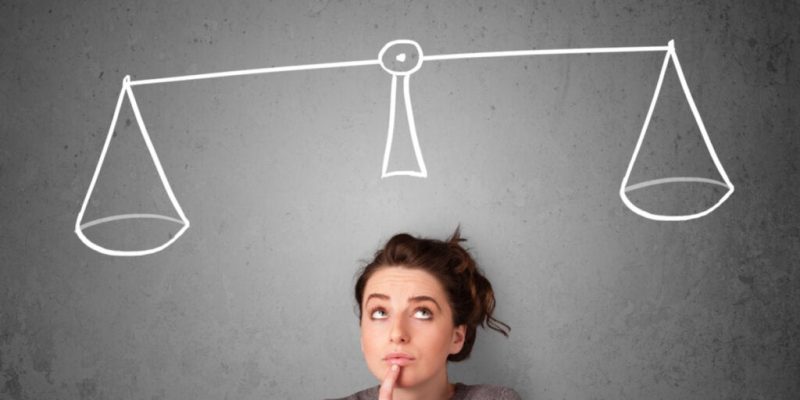One of the most important tasks of our brain is to process all the information it receives. However, it doesn’t always do it in the best way. We like to make quick judgments, label, and classify everything in a chaotic and superficial way. In fact, almost without realizing it, we allow ourselves to be dominated by distortions of thought. One of the most common is the binary bias.
This pervasive psychological effect defines our tendency to dichotomize any set of data we’re exposed to. We narrow the entire range of possibilities down to just two categories. This phenomenon happens daily on social media. The overwhelming amount of information we all receive on our devices has turned us, more than ever, into lazy thinkers.
As the bad joke goes, there are two types of people in this world, those who believe that there are two types of people and those who don’t. In the field of cognitive psychology, this idea is widely shared. We assume that there are also two types of individuals in society: those who think, reason, and decide in a dichotomous way and those who understand that the world has more options and interpretations.
“We’re blind to our blindness. We have very little idea of how little we know. We’re not designed to know how little we know.”
-Daniel Kahneman-
Binary bias
We all conceive of ourselves as fluid, reflective, and creative thinkers. However, the reality is quite different. We process information quickly and reach certain conclusions at the speed of light. The fact that we do it this way isn’t voluntary. In fact, it responds to a really primitive mechanism.
Our ancestors had to respond quickly to the needs of the environment to survive. They were forced to assess what was happening around them immediately and to decide on a response. This mechanism is still present in us, today. It’s what often urges us to see the world in overly simplified and almost always negative terms.
However, the binary bias goes beyond the simple need to save time when deciding. It’s a cognitive tendency that makes us order information into sets of two possibilities. One example of this is thinking that people can only be good or bad, that in life one succeeds or fails, or that what we read on the Internet is either all true or all false.
When making decisions we almost always see only two options
“What should I do with my life? Should I leave or stay here? Change jobs or continue in the same one? Meet new people or spend more time with my old friends? “. When we try to make decisions, we almost always end up formulating two options: one opposite to the other.
The binary bias divides the wide range of options that every challenge or problem has into two possibilities. We have an innate tendency to impose two different categories when, in fact, almost any reality or circumstance lies within a continuum where there are multiple and varied alternatives.
Nothing is completely black or white, things aren’t always good or bad, and people aren’t always either for or against us. As human beings, we move much of the time in the gray areas of life where nothing is completely conclusive. Using a label and its reverse simplifies the world and turns us into economical thinkers, people who end up limiting their great cognitive resources.
“He who thinks little, errs much”.
-Leonardo da Vinci-
Binary bias and social media
As we mentioned earlier, binary bias is becoming increasingly prevalent in the digital universe. Indeed, in this scenario, where new information arrives almost by the second, our brains have hardly any time to apply a critical and analytical perspective. We label everything ‘good’ or ‘bad’, ‘true’ or ‘false’, ‘interesting’ or ‘boring’ or ‘appropriate’ of ‘offensive’.
Research conducted by Yale University (USA) claims that when we’re exposed to information about health, finances, or public policy decisions, we respond emotionally and not rationally. We limit ourselves to being carried away by emotional valence (I like it/I don’t like it) without weighing the evidence and analyzing the information in detail.
Our society is increasingly inhabited by passive and polarized reasoners. We don’t tolerate uncertainty, nor the range of gray tones of reality. When faced with each new piece of information, we react on impulse. We no longer have time to analyze things and our critical mind is almost in danger of becoming extinct.

How to stop applying a binary or dichotomous mental approach
The best ‘treatment’ for binary bias is critical and flexible thinking. As Aaron Beck claimed, whoever reasons in terms of all or nothing and good or bad applies a childish and immature approach. Thinking in absolute terms leads to existential malaise and irritability, and it completely limits our learning opportunities.
The only way to combat this perspective is by tolerating ambiguity, uncertainty, and contradiction. After all, our reality is tremendously complex and even contradictory. Only by being able to assume the whole kaleidoscope of options will we embrace well-being and intellectual enrichment.
So try and be critical, curious, and open-minded. Make sure you practice the kind of mental gymnastics that prevents you from being left with only two options when faced with any vital information or challenge.
The post The Binary Bias: A Simplified Way of Processing Information appeared first on Exploring your mind.



















Comments